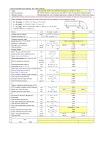
Welding Definitions
Welding is the joining of multiple pieces of metal by the use of heat and or pressure. A union of the parts is created by fusion or recrystallization across the metal interface. Welding can involve the use of filler material, or it can involve no filler.
To look at the changes in microstructure and the hardness in the Heat Affected Zone (HAZ)
Welding defects, their cause and preventative Measures
Industrial radiography techniques
What commercial and technological importance does welding have?
✓ Provides a permanent joint
✓ Weld joint can be stronger than parent material ( If the filler material has superior strength characteristics and proper techniques are used)
✓ Usually the most economical way to join components
✓ Can be done in the field away from a factory
Type of Welding:
❑ Arc Welding
❑ Tig Welding
Purpose
To become more familiar with the welding process and its effects on the materialTo look at the changes in microstructure and the hardness in the Heat Affected Zone (HAZ)
Welding defects, their cause and preventative Measures
Industrial radiography techniques
What commercial and technological importance does welding have?
✓ Provides a permanent joint
✓ Weld joint can be stronger than parent material ( If the filler material has superior strength characteristics and proper techniques are used)
✓ Usually the most economical way to join components
✓ Can be done in the field away from a factory
Type of Welding:
❑ Arc Welding
❑ Tig Welding
Arc Welding
❖ A fusion welding process in which the coalescence of the metals is achieved by the heat from an electric arc between an electrode and the work.Tig Welding & Gas tungsten Arc Welding (GTAW).
❖ TIG welding is a process where melting is produced by heating with an arc struck between a non-consumable tungsten electrode and the work piece. An inert gas is used to shield the electrode and weld zone to prevent oxidation of the tungsten electrode and atmospheric contamination of the weld and hot filler wire.











0 Comments